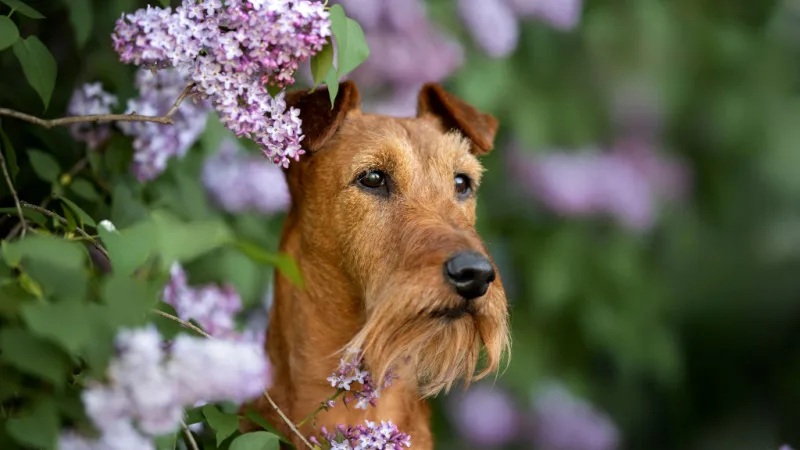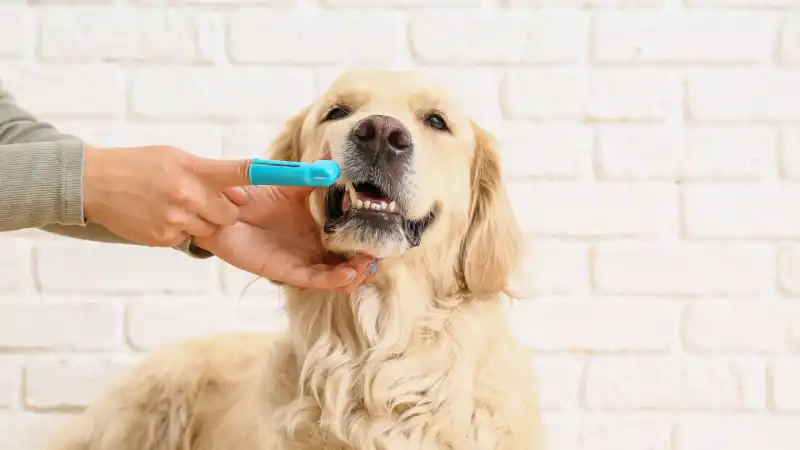Summer Safety and Gardening Tips for Dog Owners
Summer fun outdoors can be great for your dog... if you're safe. Here are safety tips for summer adventures and suggestions for dog-safe gardens and flower beds.

Pet owners may want to keep their dogs in a bubble and away from danger, but that’s impossible in the summertime! Summer's sights, sounds, and smells are overwhelming for our dogs, beckoning them outside for a sniff of blooming plants or campfire snacks. So, how do we keep them safe – and stop their noses from getting them in trouble - during the dog days of summer?
It all starts with making your pet’s environment as safe as possible - and monitoring their behavior. There are times when you can’t turn your back on your furry friend, especially if they’re near a garden, on a hike, or swimming. It’s their time to shine and pet owners want their dogs to live their best lives – but that means owners have to remain vigilant and prepared.
Keep Your Dog Safe Near Water
Did you know that as many as 5,000 dogs drown each year in backyard swimming pools? That means owners need to ensure that curious dogs are always monitored, even if they’re skilled swimmers. The first thing to remember is that not all dogs can swim, even if they’re a Labrador. If your dog is comfortable swimming, make sure you bring a life jacket or Float Coat for trips out on a lake or on a boat. When your pup is swimming, always observe their play, especially in lakes or pools where dangers are lurking everywhere – and it only takes a minute to go from fun to frightening. And lastly, your dog may overdo it in the heat, so monitor their behavior and make sure that they take breaks.
Swimming Gear
How do you set up your dog up for success if you plan to take them to a lake, beach, or pool?
Float coats or life jackets: Life jackets provide buoyancy and visibility for your dog when in the water. These save lives and are a must if your dog is swimming.
Waterproof collars: Identification is essential; removing the collar means that your dog’s tags aren’t present in case of an emergency!
Swim shirts with SPF: Some dog breeds are hairless, and the sun can cause a rash or burn their sensitive skin. Other dogs may benefit from a swim shirt to protect them from skin cancer. Products that offer SPF 50 and block 98% of the sun’s rays are a good choice.
Water-Loving Canines Enjoy Backyard Pools
Are backyard pools safe? For the most part, pools are likely the safest place for your dog to swim, but pool toys make dogs curious, causing them to jump in unattended. They can choke on pieces when no one is watching.
Paws Are a Concern at the Beach
Pet owners need to consider the temperature of the sand and bring boots for their dogs in case it’s too hot. Wearing boots can help prevent paw pad injuries caused by sharp rocks and other dangers like fish hooks. Dog owners may also find more summer safety information here.
Boating Days
Some of the best Instagram posts are of dogs on boats. Yet, most of the dogs on IG aren’t wearing life jackets! So, if your dog falls overboard without a life jacket, they will likely get fatigued quickly and are at risk of drowning. In addition to a float coat, there are other ways to ensure your boat trip is safe:
Remove the fishing gear and tackle or put it in a locked container.
Grab a doggy boat ladder to make exiting the water much more manageable.
Set up a boat alarm, where your dog wears a remote collar that sounds an alarm if they go overboard.
Check before you board to ensure that the deck isn’t too hot or slippery.
Bring towels and water.
Quick Checklist for Camping and Hiking with Canines
Plan and prepare for your trip well in advance because camping with your doggo may be challenging if you’ve never done it before. Where you stay may alleviate some of the stress of traveling with your pet on a vacation. Try choosing a camp site you’re familiar with that has rules asking pet owners to keep their dog on a leash on trails, as well as near neighboring tents.
RV Camping = Glamping
Check the rules at the campground before you leave. Tent camping is much different than RV camping. If your dog isn’t comfortable with strangers close by, they’re probably best suited for an RV or something more private. Unless you do your research, your campsite and tent may be located directly next to someone else with 5 dogs all on tie-outs!
When Should You Hit the Trails?
The rule of thumb when hiking with your dogs is to hit the trails on off hours. Take your dog for a hike during the early morning hours before the temperatures soar and every family there decides to get out and find the local swimming hole. The park staff will help you determine what trails are best and which are the most crowded during the peak summer months.
What About the Terrain?
Carrying your exhausted dog back to the campsite is a lot of work. Warm days are not the best time to take your doggo on a long hike with difficult terrain.
This rule applies to all dogs, but especially brachycephalic breeds. Dog boots will also help avoid paw pad injuries from rocky terrain.
Dog owners shouldn’t assume their dog can make the trek up to their fave viewpoint. Factors like high altitude might affect your dog’s ability to keep up with you.
A First-Aid Kit May Save Your Dog
This may be the most important rule of the trip. Make sure your pet’s first-aid kit is not only restocked for vacation, but also focused on injuries that occur while you’re out in the wilderness. Don’t forget Benadryl for bug bites!

Every Dog and Cat Deserves the Pet Insurance of Champions
Get prize-winning care for your pets.
Pet-Proof Your Garden: Create a Pet-Friendly Environment
Is this like puppy-proofing your house? Unfortunately, yes! To enjoy gardening, you must keep your dog safe and out of any areas with plants, flowers, or veggies. The only way to stay out of the emergency vet during the summer is to use wildlife fencing, netting, containers or pots, safe fertilizer, and pet-friendly mulch.
Use Raised Beds or Pots as Alternatives
Consider raised beds or containers for plants, veggies, and flowers. Container gardening is popular, and you never have to worry about your dog consuming bulbs or berries before you harvest all the goods. Also, putting up wildlife netting or a small fence around your pots and raised beds is easy.
Does Netting Keep Dogs Safe?
Netting is a safe alternative and works better than the trendy motion sensor sprinkler systems you’ll see in your neighbor’s yard. The type of netting used to keep deer out of gardens is perfect for dogs. It is draped across metal poles and secured at the bottom with sod staples. It will keep out dogs, rabbits, deer, and raccoons.
Design An Herb Garden
Your dog likely eats grass and other herbs in the yard throughout the summer, and there are reasons certain plants are a focus for canines. For example, cleavers are an excellent weed for your dog to enjoy before it starts to flower. Also known as the ‘sticky weed,’ this plant helps dogs with inflammation. In addition, cleavers love to grow around lavender and other popular herbs found in gardens across the U.S.
These five are perfect for a dog-safe garden:
Cleavers: This sticky weed is excellent for your dog’s lymphatic system.
Dandelion: Dandelion greens support the cardiovascular system.
Mint: An excellent option to add to meals to support overall oral health.
Rosemary: This herb helps the digestive system.
Basil: Basil has anti-inflammatory properties.
Some herbs and weeds may be mistaken, though, for toxic plants. Therefore, pet owners must watch their dogs to ensure they are not consuming poisonous plants (or any herb in excess amounts). A small amount of the above herbs is fine.
Poisonous Summer Plants for Pets
Pet owners must check whether their garden and ornamental plants are pet-friendly or toxic. If there is any question about a plant your dog nibbled on, call the ASPCA Pet Poison Helpline immediately. With some plants, it’s the bulbs that are toxic, and in other cases, every part of the plant is dangerous if ingested. Steer clear of the following plants:
Apple tree
Azaleas
Buttercup
Daffodils
English Ivy
Foxglove
Iris
Lupine
Milkweed
Nightshade
Poison Hemlock
Rhododendron
Wisteria
Yew
Yucca
Veggies Best Suited for Containers
Onions and the leaves of tomato plants are toxic to dogs. If you need to grow these hazardous veggies, only planted in a raised bed or container with netting.
Many Common Fertilizers and Mulches Are Toxic
Almost every gardener makes the rookie mistake of adding toxic mulch or fertilizer to plants, not realizing they will cause gastrointestinal upset and are not pet-friendly. Research and talk with your local garden supply store about options in your region that won’t harm pets. The three biggest culprits that will likely cause vomiting, diarrhea, and a trip to the vet include:
Cocoa mulch: Also known as cocoa bean mulch, it contains compounds toxic to dogs.
Chicken manure: Manure used as fertilizer can carry salmonella and make your dog sick.
Fish emulsion: Large quantities of this fertilizer will cause an upset stomach and vomiting.
Summer Is the Season to Sign Up for Pet Insurance
For the best dog and cat insurance around, check out AKC Pet Insurance. Accident & Illness Coverage (underwritten by Independence American Insurance Company) allows you to focus more on the health of your pet and less on expensive veterinary bills.
AKC Pet Insurance is the pet insurance of champions and the only brand offering coverage for curable and incurable pre-existing conditions*.

Every Dog and Cat Deserves the Pet Insurance of Champions
Get prize-winning care for your pets.
*Not available in all states. Pre-existing condition coverage available after 365 days of continuous coverage. “Only brand“ refers to comparison with 5 pet insurance carriers making up approximately 80% of the US pet insurance market (Nationwide, ASPCA, Trupanion, HealthyPaws and PetPlan).
Christy is a writer, editor, blogger, chicken keeper, and storyteller. She uses her knowledge as a certified veterinary technician to inform animal lovers on health and wellness topics. Christy's Standard Dachshund and Beagle mix are the inspiration behind her writing portfolio and essays.
READ MORE ARTICLES

